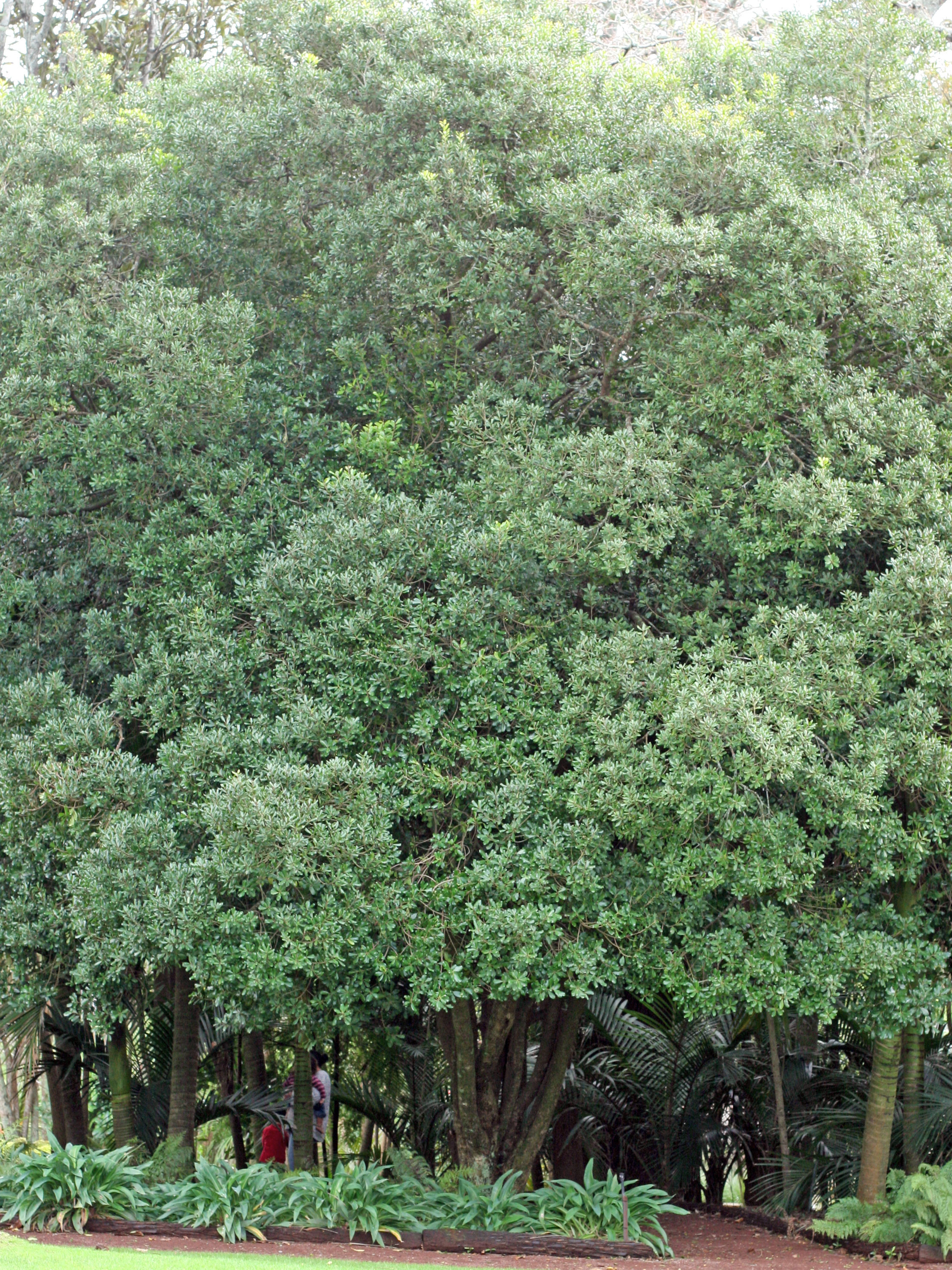- Pouteria costata
Taxobox
name = "Pouteria costata"

image_width = 240px
regnum =Plantae
divisio =Magnoliophyta
classis =Magnoliopsida
ordo =Ericales
familia =Sapotaceae
genus = "Pouteria "
species = "P. costata"
binomial = "Pouteria costata"
binomial_authority = ( Endl. ) Baehnisynonyms = "Planchonella costata"
"Planchonella novo-zelandica"
"Pouteria novo-zelandica"
"Planchonella costata var. austro-montana"
"Pouteria costata var. austro-montana""Pouteria costata" is a small coastal tree native to the northern
North Island (New Zealand ) and toNorfolk Island (Australia ). In New Zealand, its common name is Tawapou (Tawāpou in Māori); on Norfolk Island it is called Bastard Ironwood. The name "costata" is from the Latin "costatus" (ribbed), a reference to the prominently raised primary nerves of the leaves. "Pouteria " is a genus of approximately 300 species in the tropics of America, Asia, Australia and the Pacific. A "Pouteria" species found in other Pacific Islands is sometimes erroneously included in "P. costata".Distribution
. It grows from sea level to about 450 m, always close to the sea. It is not regarded as threatened in New Zealand.
Description
"P. costata" is fairly slow growing, closely branched tree that prefers coastal conditions. It grows up to 20 m tall with a trunk to 1 m in diameter. The bark is rough and varies in colour from grey to brownish-grey. It prefers semi-shade, and is frost tender. The dark green lustrous leaves measure from 5 to 10 cm (sometimes up to 15 cm) long and 2 to 5 cm wide. The main vein in the centre of the leaf is distinct above and below, as are the primary veins on each side of it, which number from 14 to 20. The branchlets and leaf stems are covered with fine flattened hairs. The tiny, delicate flowers, only 4-6 mm in diameter, usually arise from the leaf axils, but also directly from the branchlets. The tree produces large multi-coloured berries 2.5 to 4 cm long which enclose 2 to 4 hard, hard, curved, almost polished seeds, almost as long as the berry, which were used by the Māori to make necklaces. The berries undergo successive stages of colour from green to orange to a very dark red as they ripen, a process that can take from 12 to 15 months. The berries are heavy and will fall from the tree easily if it is disturbed. According to Salmon, a tree with a heavy crop of berries is a spectacular sight (1973:278). When wounded, the tree exudes a sticky, white latex. The white-coloured wood is hard and durable. The fruit are consumed by the
kererū , the New Zealand pigeon, and thekākā parrot, both of which are represented on Norfolk Island by closely related birds which are now extinct.Threats
sometime in the last 1,000 years and became widespread on the three main islands, and reached many of the offshore islands. Tawapou seedlings and saplings are now rare on the mainland and on off-shore islands where kiore are present, and abundant on islands where they are absent. Where kiore are present, it is rare to find tawapou seeds that have not had their kernels removed. Kiore eat the flesh from freshly-fallen tawapou fruit but tend to take the seeds to 'husking stations' where they remove the kernels. As many as 1,400 discarded husks have been found at a single site. The number of juvenile trees increases markedly on islands from which kiore have been removed. "The apparent thoroughness with which kiore find and eat the kernels before the seed germinates shows that kiore can substantially reduce seedling numbers… Numbers of tawapou, and the proportion of tawapou trees in forest vegetation, will increase after rat eradication on any island that still retains tawapou trees" (Campbell et al., 1999:280). Norfolk Island also has various species of rats, which no doubt contributes to the endangered status of "P. costata" there.
In Māori culture
Tawapou logs were often used as rollers to help bring large canoes onshore. In Māori traditions of Northland, the canoe 'Waipapa' is said to have landed in
Doubtless Bay . The captain asked his crew to take the rollers of the canoe, which had been carried fromHawaiki , and plant them on a the slopes of a nearby hill. From the rollers grew a grove of tawapou ("P. costata") trees that today serve as a memorial of the arrival of the canoe. Similar stories are told of groves of tawapou trees at Houhoura Harbour and Aurere Beach. The Mamaru canoe, whose descendants live around Doubtless Bay and nearKaitaia , carried in its crew an important ancestor named Pou. It is possible that the word 'tawapou' derives from 'Tawa-a-Pou' 'the Tawa trees of Pou'. A legend from East Cape relates to the Takitimu canoe, which was followed by a flock ofKākā parrots as it left Hawaiki. They gorged on tawapou berries to sustain them on the long flight. When they reached East Cape they disgorged the seeds, which grew, and eventually the tawapou trees spread along the coast.References
* Salmon J T, "The Native Trees of New Zealand", AH & AW Reed, Wellington, New Zealand, 1973. ISBN 0-589-01340-8
*cite web |title="Pouteria costata" — Bastard Ironwood |work=Australian Government Species Profile and Threats Database |url=http://www.environment.gov.au/cgi-bin/sprat/public/publicspecies.pl?taxon_id=22046|accessdate=2007-07-18
*cite web |title="Pouteria costata" |work= Flora of Australia Online |url=http://www.anbg.gov.au/abrs/abif/flora/stddisplay.xsql?pnid=5422|accessdate=2007-07-18
*cite web |title= November 2006 newsletter |work=Bushmansfriend |url= http://www.bushmansfriend.co.nz/xurl/PageID/12274/ArticleID/-62071/function/moreinfo/content.html |accessdate=2007-07-18
*cite web |title="Pouteria costata" |work=The Native Plant Centre |url=http://www.nznativeplants.co.nz/shop/Specimen+trees/Pouteria+costata.html |accessdate=2007-07-18
*cite web |title="Planchonella costata" |work=New Zealand Plant Conservation Network |url= http://www.nzpcn.org.nz/vascular_plants/detail.asp?PlantID=2285|accessdate=2007-07-18
*cite web |title="Pouteria costata" (Endl.) Baehni |work=Australian Plant Name Index (APNI) |url=http://www.anbg.gov.au/cgi-bin/apni?taxon_id=64073|accessdate=2007-07-20
*cite web |author=D. J. Campbell, I. A. E. Atkinson |date=1999 |title=Effects of kiore ("Rattus exulans" Peale) on recruitment of indigenous coastal trees on northern offshore islands of New Zealand |work=Journal of The Royal Society of New Zealand |publisher=Vol. 29 No 4, December 1999, pp. 265-290 |url=http://www.rsnz.org/publish/jrsnz/1999/18.pdf|accessdate=2007-06-17
Wikimedia Foundation. 2010.
